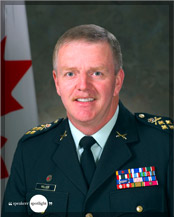General Rick Hillier

Since becoming Canada's top soldier in February 2005, Gen. Rick Hillier has been fighting two battles, each with his trademark passion and urgency.
The first has been on the ground in Afghanistan, as Canada's traditional peacekeeping role segued dramatically into a heavy combat mission in the scorching hills of Kandahar.
About 600 troops were serving in the relative safety of the capital, Kabul, with NATO's International Security Assistance Force when Hillier became chief of defence staff. Within three months, Canada was sending just over 1,200 troops to the unsettled province of Kandahar and by April 2008, when Hillier announced he would step down, Canada had 2,500 troops committed to Afghanistan. By then, the mission had been extended twice.
Away from the battlefield, Hillier waged another all-out campaign, this one for the hearts and minds of Canadians. In his folksy, Newfoundland manner, Hillier rarely pulled punches in his support of the military and the mission.
It has added to his reputation as a 'soldier's soldier', a military leader who put the welfare of his troops above all else.
His straight talk paid off, at least as far as the Canadian military is concerned. Hillier leaves behind a reinvigorated military, which had suffered from years of neglect by Ottawa. Canada's military is receiving big-ticket hardware, from transport planes to armoured trucks and unmanned drones.
The most outspoken Canadian military leader in a generation, he leaves a renewed military, equipped with new aircraft, vehicles and other equipment as well as real-life battle experience that has earned the notice of the world. As a tireless military advocate, he raised the profile of Canada's military, which endeared him to his troops and gave Canada an important card to play at the NATO table.
Married with two sons, Hillier, according to his official biography, "enjoys most recreational pursuits but, in particular, runs slowly, plays hockey poorly and golfs not well at all." This has not stopped him, however, from introducing one of his less well-known innovations — making the current military one of the more physically fit fighting units in Canadian history.